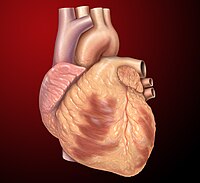
Photo from wikipedia
Acute heart failure (HF) is commonly caused by a cardiomyopathy with one or more precipitating factor. Here, a case in which a cardiomyopathy is precipitated by pulmonary embolism (PE). A… Click to show full abstract
Acute heart failure (HF) is commonly caused by a cardiomyopathy with one or more precipitating factor. Here, a case in which a cardiomyopathy is precipitated by pulmonary embolism (PE). A 77-year-old man is admitted for breathlessness and leg swelling. A mild reduction of left ventricular (LV) ejection fraction is found, with moderately increased LV wall thickness and pulmonary hypertension; clinical examination revealed signs of congestion with bilateral leg swelling, and mild signs of left HF with the absence of pulmonary congestion on chest X-ray. The ECG showed Mobitz I second-degree atrioventricular block. The clinical scenario led us to the diagnosis of infiltrative cardiomyopathy due to cardiac amyloidosis (CA) precipitated by PE. Pulmonary embolism is an overlooked precipitant of HF and can be the first manifestation of an underlying misdiagnosed cardiomyopathy, especially CA. 3,3-Diphosphono-1,2-propanodicarboxylic acid scan is a cornerstone in the diagnosis of Transthyretin amyloidosis (ATTR) cardiac amyloidosis.
Journal Title: BMJ Case Reports
Year Published: 2021
Link to full text (if available)
Share on Social Media: Sign Up to like & get
recommendations!